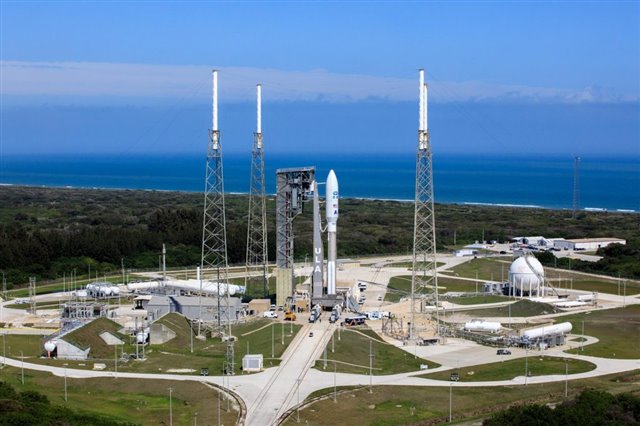After United Launch Alliance’s successful launch of their Vulcan Centaur rocket on the 8th of January, curious eyes may wonder why the rocket is surrounded by four large towers. In fact, if you are a regular observer of rocket launches, you may notice similar towers surrounding rockets at launch pads around the world.

Lift-off of the Vulcan Centaur on January 8, 2024, by United Launch Alliance (ULA). Photo credit: NASASpaceflight
Microwave-Safe Rockets
Even more curious eyes may notice that the towers aren’t just free-standing but are connected, tip-to-tip, by cables which then also sprawl away from the tips and towards the ground – forming a metal cage that surrounds the rocket. This arrangement of conductive material, known as a Faraday Cage, is the reason why we can safely microwave food, sometimes lose cellular connection in elevators, and can travel inside cars and planes without worrying about what lightning may do to us. A Faraday Cage takes advantage of the principle of electromagnetic shielding – guiding external or internal charges along its surface to prevent them from passing through to the other side. For microwaves, this warms your food and not you. For rocket launch pad lightning protection towers, this protects the rocket inside from external electric fields, such as those produced by a nearby strike.
Attracting Lightning
Furthermore, each tower is tipped with a conductive rod to attract the lightning and redirect it somewhere safe. While it may seem counterintuitive for the lightning protection system to attract lightning, doing this provides more certainty as to the location and frequency of strikes. These conductive rods can then redirect a strike safely through the Faraday Cage and then to the ground. This provides the lightning with an “easy” path to ground (known as the “path of least resistance”) which it will always follow in preference to more resistive paths (e.g., through the rocket). Armed with this information, scientists and engineers at the site can better predict the required infrastructure to weather even the worst storms.
This may include deciding the number of wires and their thickness to carry the large electrical currents induced by a lightning strike and their maintenance in response to degradation (an important consideration given that most launch sites exist near the coast where salt water degradation of metal is common). To exemplify the electrical intensity on this infrastructure, consider a storm at NASA Kennedy’s Launch Pad 39B on April 2, 2022, which produced four strikes on the pad. One of these strikes induced a current of almost 3,000 amps through the ground (Cawley, 2022) which is more than some ultra high-voltage power lines used to power entire cities.

A lightning strike is recorded at Launch Complex 39B at NASA’s Kennedy Space Center in Florida on April 2, 2022. Photo credit: NASA
Examples
Different launch pads implement this cone of protection in different ways, mainly depending on the size of the protected area and the expected intensity of lightning. For example, Space Launch Complex-41 (SLC-41) at Cape Canaveral Space Force Station (which launched Vulcan Centaur) has four of these towers. This is an artefact of the Titan rocket program (1959 – 2005) which allowed work at the pad even during thunderstorms, explaining the requirement for a larger cone of protection.

Canaveral Space Force Station’s Space Launch Complex 41. Photo credit: NASA/Kim Shiflett
Another characteristic of this pad is that the wires, which are held up by white rods, tend to sprawl towards the ground and away from the rocket. These rods are called “candlesticks”, and they are made from fibreglass, an insulating material which makes the tower a much more “difficult” path for the lightning to pass through. Therefore, it is much “easier” for the lightning to pass through the wires alone that sprawl downwards and away from the rocket, rather than through the towers themselves where oxidisers, fuels, and (in older programs) people may be during a thunderstorm.
However, each wire can only carry so much discharge before it degrades and so if more frequent and intense lightning is expected in an area, more wires to ground may be required. This is emphasised by the fact that most launch sites are located on the equator (to maximise the speed boost to the rocket provided by the rotation of the Earth) which is also where lightning is more common (NASA Earth Observatory, 2006). There are many ways to provide a cone of protection around a rocket, some sites do it with four towers and candlesticks (e.g., SLC-40 and SLC-41), some with two towers that connect their wires to a moveable service tower (e.g., SLC-37B), and some with just a single tower (e.g., SLC-39A).
Conclusion
In conclusion, the seemingly innocuous towers surrounding rocket launch pads are incredibly important pieces of infrastructure that safeguard rockets and their payloads from mission-ending lightning strikes. Whilst the design of the lightning protection system is different for each pad and involves complex engineering, they all rely on simple principles such as Faraday Cages and electrical paths of least resistance to keep these multi-million dollar assets safe.
-

Lisa Miles
-
Cancel
-
Vote Up
0
Vote Down
-
-
Sign in to reply
-
More
-
Cancel
Comment-

Lisa Miles
-
Cancel
-
Vote Up
0
Vote Down
-
-
Sign in to reply
-
More
-
Cancel
Children